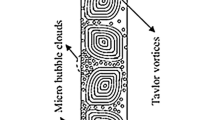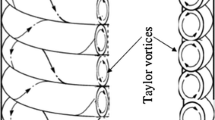Abstract
In this paper, frictional drag reduction by small bubbles is studied experimentally on shear flow between co-axial cylinders in a Couette-Taylor system. In this system, the internal cylinder is rotatory while the outer cylinder is stationary. A porous body is used to produce small bubbles, and to avoid the uncertain interfacial property of bubbles, distilled water is used. For the entire range of tested rotational Reynolds numbers in this study, the circumferential flow is fully turbulent due to rotation of inner cylinder and Taylor vortices appeared in annulus gap. The effect of small bubbles on the drag reduction is investigated by measuring the torque exerted on the inner cylinder. The results show that drag reduction ratio is increased in the presence of air bubbles when the rotational Reynolds number is enhanced up to a certain value (\( \text{Re}_{\omega c} = 50.4 \times 10^{3} \)). However, the effect of small bubbles is inversed for rotational Reynolds number greater than \( \text{Re}_{\omega c} \) which is due to the accumulation and creation of bubble clouds near the inner cylinder surface. In this study, the effect of drag reduction on sensitivity and power gain factor are assessed, with the results showing that the sensitivity exceeded unity at \( \text{Re}_{\omega }\,<\,\text{Re}_{\omega c} \) and power gain factor reached its maximum value at \( \text{Re}_{\omega c} \).





















Similar content being viewed by others
Abbreviations
- r :
-
Radius
- D :
-
Diameter
- L :
-
Cylinder length
- C f :
-
Skin friction coefficient
- T :
-
Torque acting on rotating inner cylinder
- Q a :
-
Air flow rate
- S :
-
Sensitivity
- k :
-
Power gain
- g :
-
Gravity acceleration
- U :
-
Velocity
- \( u^{\prime} \) :
-
Velocity fluctuation
- \( i \) :
-
Turbulence intensity
- \( \text{Re} \) :
-
Reynolds number
- \( Ta \) :
-
Taylor number
- \( Fr \) :
-
Froude number
- \( We \) :
-
Weber number
- \( \tau_{w} \) :
-
Wall shear stress
- \( \eta \) :
-
Drag coefficient ratio
- \( \rho \) :
-
Water density
- \( \nu \) :
-
Kinematics’ viscosity
- \( \omega \) :
-
Angular velocity
- \( \delta \) :
-
Gap width
- \( \alpha \) :
-
Void fraction
- \( \sigma \) :
-
Tension surface
- \( \varepsilon \) :
-
Total dissipation rate
- \( \omega \) :
-
Rotational
- w :
-
Water
- a :
-
Air
- 1:
-
Inner cylinder
- 2:
-
Outer cylinder
- w :
-
Wall
- b :
-
Bubble
- f :
-
Friction
- 0:
-
Single phase flow
References
McCormick ME, Bhattacharyya R (1973) Drag reduction of a submersible hull by electrolysis. Nav. Eng. J. 85:11–16
Bogdevich VG, Evseev AR, Mayyuga AG, Migirenko GS (1977) Gas-saturation effect on near-wall turbulence characteristics, In: Drag Reduction. Paper Presented at the Second International Conference on Drag Reduction, pp D2-25–D2-37
Madavan NK, Deutsch S, Merkle CL (1984) Reduction of turbulent skin friction by micro bubbles. Phys Fluids 27:356–363
Madavan NK, Merkle CL, Deutsch S (1985) Numerical investigations into the mechanisms of micro bubble drag reduction. J Fluids Eng 107:370–377
Merkle CL, Deutsch S (1989) Microbubble drag reduction. In: Gad-el-Hak M (eds) Frontiers in Experimental Fluid Mechanics, vol 46. Lecture Notes in Engineering, pp 291–335
Deutsch S, Castano J (1986) Microububble Skin Friction Reduction on an Axisimmetric Body. Phys Fluids 29:3590–3597
Clark H, Deutsch S (1991) Microbubble skin friction reduction on an axisymmetric body under the influence of applied axial pressure gradients. Phys Fluids A 3:2948–2954
Kodama Y, Kakugawa A, Takahashi T, Kawashima H (2000) Experimental study on microbubbles and their applicability to ships for skin friction reduction. Int J Heat Fluid Flow 21:582–588
Xu J, Maxey MR, Karniadakis GE (2002) Numerical simulation of turbulent drag reduction using microbubbles. J Fluid Mech 468:271–281
Shen X, Ceccio SL, Perlin M (2006) Influence of bubble size on micro-bubble drag reduction. Exp Fluids 41:415–424
Wu SJ, Hsu CH, Lin TT (2007) Model test of the surface and submerged vehicles with the micro bubble drag reduction. Ocean Eng 34:83–93
Jacob B, Olivieri A, Miozzi M, Campana EF, Piva R (2010) Drag reduction by micro bubbles in a turbulent boundary layer. Phys Fluids 22:115104
Amromin E, Mechmath LLC, Prior Lake MN (2010) Micro bubble drag reduction downstream of ventilated partial cavity,). J Fluids Eng 132:1–5
Fa TJ, Chuan CC (2011) Boundary layer mixture model for a micro bubble drag reduction technique. ISRN Mech Eng, pp 1–9
Murai Y, Oiwa H, Takeda Y (2008) Frictional drag reduction in bubbly Couette-Taylor flow. Phys Fluids 20:034101
van den Berg TH, Luther S, Lathrop DP, Lohse D (2005) Drag reduction in bubbly Taylor-Couette turbulence. Phys Rev Lett 94:044501
van den Berg TH, van Gils DPM, Lathrop DP, Lohse D (2007) Bubbly turbulent drag reduction is a boundary layer effect. Phys Rev Lett 98:084501
Sugiyama K, Calzavarini E, Lohse D (2008) Micro bubbly drag reduction in Taylor-Couette flow in the wavy vortex regime. J Fluid Mech, pp 1–30
van Gils DPM, Guzman DN, Suny C, Lohsey D (2013) The importance of bubble deformability for strong drag reduction in bubbly turbulent Taylor-Couette flow. J Fluid Mech 722:317–347
Maryami R, Farahat S, Javad PM, Shafiei MMH (2014) Bubbly drag reduction in a vertical Couette-Taylor system with superimposed axial flow. Fluid Dyn Res 46:1–27
Chouippe A, Climent E, Legendre D, Gabillet C (2014) Numerical simulation of bubble dispersion in turbulent Taylor-Couette flow. Phys Fluids 26:043304
Bilgen E, Boulos R (1973) Functional dependence of torque coefficient of coaxial cylinders on gap width and Reynolds numbers, Transactions of ASME, J. Fluid Eng. Ser I 95:122–126
Sakaue K, Takagi M (1983) Separation of overlapping particles by iterative methods. Johoshori Gakkai Ronbunshu 24–5:561–567
Song X, Yamamoto F, Iguchi M, Shen L, Ruan X, Ishii M (1998) A method for measuring particle size in overlapped particle images. ISH Int 38:971–976
Takahara K, Etoh T, Michioku K, Kuno S (1997) A study on particle identification in particle mask correlation method. In: Proceedings of 2nd International Work shopon PIV ‘97, Fukui, pp 213–220
Ohta J, Mayinger F, Feldmann O, Gebhard P (2001) An algorithm for evaluating overlapping bubble images recorded by double pulsed laser holography. J Visual 4:285–298
Otsu NA (1979) Threshold selection method from gray-level histogram, IEEE Trans. System Man Cybernet SMC 9–1:62–66
Andereck CD, Liu SS, Swinney HL (1986) Flow regimes in a circular Couette system with independently rotating cylinders. J Fluid Mech 164:155–183
Cazley CJR (1985) Heat trasfer characteristics of the rotational and axial flow between cocentric cylinders. Trans ASME 80:77–90
Lu J, Fernadez A, Tryggvason G (2005) The effect of bubbles on the wall drag in a turbulent channel flow. Phys Fluids 17:1–12
Legner HH (1984) A simple model for gas bubble drag reduction. Phys Fluids 27:2788–2790
Lewis GS, Swinney HL (1999) Velocity structure functions, scaling, and transitions in high-Reynolds-number Couette-Taylor flow. Phys Rev E 59:5457–5467
Ferrante A, Elghobash S (2007) On the accuracy of the two-fluid formulation in direct numerical simulation of bubble-laden turbulent boundary layers. Phys Fluids 19:1–8
Sugiyama K, Kawamura, T, Takagi, S, Matsumoto, Y, The Reynolds number effect on micro bubble drag reduction. In: Proceedings of the 5th Symp. on Smart Conrol of Turbulence, The Uni. of Tokyo, Tokyo, pp 31–43
Author information
Authors and Affiliations
Corresponding author
About this article
Cite this article
Maryami, R., Farahat, S., JavadPour, M. et al. Frictional drag reduction using small bubbles in a Couette-Taylor flow. J Mar Sci Technol 20, 652–669 (2015). https://doi.org/10.1007/s00773-015-0319-0
Received:
Accepted:
Published:
Issue Date:
DOI: https://doi.org/10.1007/s00773-015-0319-0




